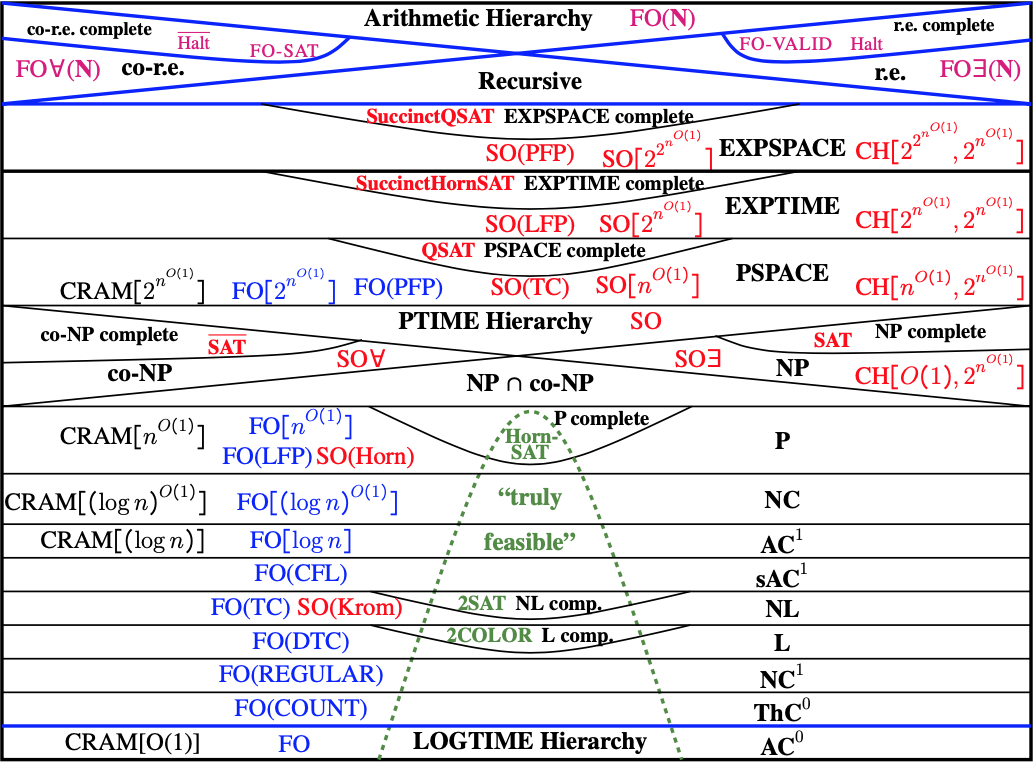
See Neil Immerman's Recent Publications, for some publications on descriptive complexity, and "Recent Talks", for video and slides of a recent survey talk on Descriptive Complexity.

In the above diagram, CRAM[t(n)] is parallel time O(t(n)) on a Concurrent-Read, Concurrent-Write Parallel
Random Access Machine, using polynomially much hardware. This is equal to FO[t(n)], the set of
problems expressible by a fixed block of first-order restricted quantifiers, recopied t(n) times
for structures of size n. CH[t(n),h(n)] is parallel time O(t(n)) on a CRAM using O(h(n)) hardware
gates.
The following are descriptive characterizations of some of the above classes. We think of all complexity theoretic problems as sets of finite structures of some vocabulary. Such a problem can be thought of as a boolean-valued query on relational databases. The following characterizations assume that there is a given total ordering on each input structure.
This means that the boolean queries computable in parallel-time t(n) are exactly those expressible by formulas consisting of a fixed quantifier block, iterated t(n) times, and this is the same as the set of boolean queries expressible via first-order inductive definitions that close in t(n) steps. CRAM[t(n)] means parallel time t(n) on a concurrent read and concurrent write paralllel random access machine that has at most a polynomial amount of memory and processors.
The boolean queries computable using deterministic space n to the power k are exactly those expressible via a block of quantifiers that may be iterated exponentially many times --- as a function of the size of the input structure --- but use only k+1 domain variables.
In the lowest level of our chart, the logarithmic-time hierarcy is equal to the set of first-order expressible boolean queries. It is also equal to the set of boolean queries accepted by a uniform sequence of bounded-depth, unbounded fan-in, polynomial-size circuits and to those computable in constant parallel time.
Deterministic Logspace is equal to the set of boolean queries expressible in first-order logic, extended by a deterministic transitive closure operator. Yuri Gurevich gave an alternate characterization of logspace as the set of boolean queries computable by the "finite, primitive-recursive" functions.
Nondeterministic Logspace is equal to the set of boolean queries expressible in first-order logic, extended by a transitive closure operator. This is also equal to the set of second-order boolean queries in which the first-order part is a universal formula in "Krom" form, i.e., conjunctive normal form with at most two literals per clause. This later characterization is due to Erich Grädel.
For any formula, ϕ(x1,. . .,xk, y1, . . .,yk), TC(ϕ) denotes the reflexive, transitive closure of the binary relation ϕ. DTC(ϕ) is equal to TC(ϕd) where ϕd is the deterministic reduct of ϕ,
ϕd(x,y) <=> ϕ(x,y) & (∀ z)(ϕ(x,z) -> z = y)
Polynomial Time is the set of boolean queries expressible in first-order logic extended by the ability to define new relations by induction. This is formalized via a Least Fixed Point operator. This is sometimes called the Immerman- Vardi Theorem. P is also equal to the set of boolean queries expressible by a quantifier block iterated polynomially many times. Finally, P is equal to second-order boolean queries in which the first-order part is a universal formula in "Horn" form, i.e., conjunctive normal form with at most one positive literal per clause. This later characterization is due to Grädel.
Nondeterministic Polynomial Time is equal to the set of boolean queries expressible in second-order, existential logic. This is Fagin's Theorem
The Polynomial-Time Hierarchy is equal to the set of boolean queries expressible in second-order logic.
Polynomial Space is the set of booean queries expressible by first-order quantifier blocks iterated as much as is useful, i.e., exponentially. This is captured by the power of a Partial Fixed Point Operator. PSPACE can also be charcterized by second-order formulas iterated polynomially many times. A transitive closure operator added to second-order logic captures this.
Second-Order quantifier blocks iterated t(n) steps times describe the boolean queries computable in parallel time t(n) using exponentially much hardware: "CH[t(n), h(n)]" stands for simultaneous CRAM time O(t(n)) using O(h(n)) hardware gates. Thus, the polynomial-time hierarchy contains those boolean queries computable in constant time using exponentially much hardware. PSPACE is the set of queries computable in polynomial time using exponentially much hardware.
Exponential time is the set of boolean queries computable in second-order logic extended with the capacity to define new relations by induction. This is the same as second-order quantifier blocks that may be iterated exponentially.
Descriptive Complexity is part of Finite Model Theory, a branch of Logic and Computer Science.
Thanks to NSF grants CCR-8105754, Mathematical Sciences Postdoctoral Research Fellowship 8311679, CCR-8603346, CCR-8806308, CCR-8996280, CCR-9008416, CCR-9207797, CR-9505446, CCR-9877078, CCF-0207373, CCF-0514621, CCF-0830174, CCF-1115448, CCF-1617498 which helped to support some of the research described on this page.